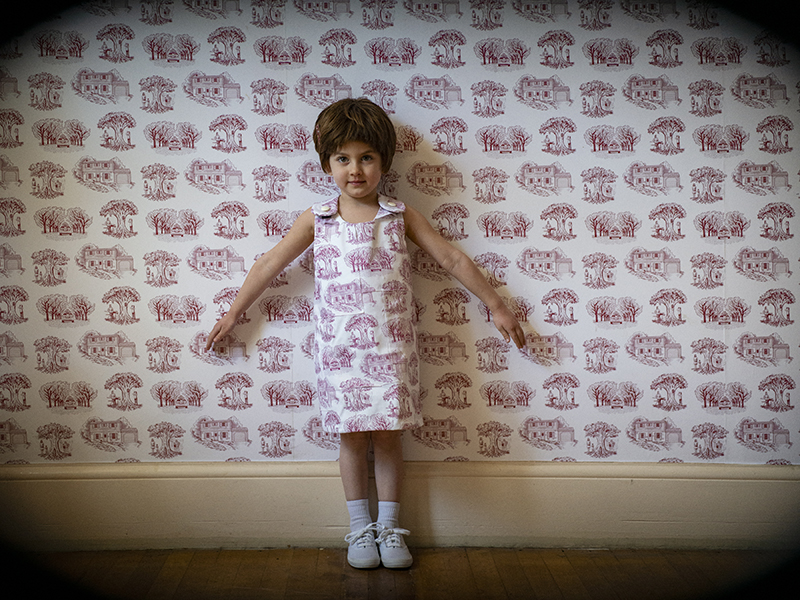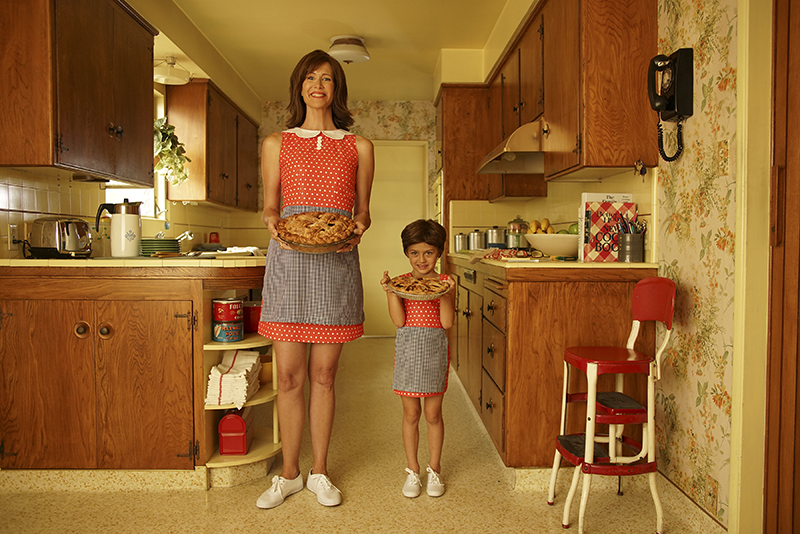Jona Frank: Model Home
By Bowdoin College Museum of Art
Home, from Cherry Hill, 2020, archival pigment print by Jona Frank. © Jona Frank
On February 24th, the Bowdoin College Museum of Art (BCMA) will open Jona Frank: Model Home. On view until June 5th, the show features an immersive installation created by the artist Jona Frank (American, born 1966) in collaboration with the designer Alex Kalman. Growing out of a photographic project designed to document her upbringing in Cherry Hill, New Jersey, during the 1970s and 1980s, Jona Frank: Model Home addresses the challenges the young artist experienced attempting to conform herself to her mother’s traditional expectations. While using the language of photography, the artist simultaneously acknowledges and subverts the suburban rituals with which it is associated. Tacitly pointing to the common tendency to “perform” a particular role for the camera, Frank’s self-investigation does not directly picture the photographer and her family, but instead uses surrogates: actor Laura Dern portrays her mother, while younger actors depict a maturing Frank. Forbidden as a child from handling the family camera (an experience “documented” by Frank), the artist plays with the residue of memory filtered through snapshots. In this assemblage of unsettling “Kodak moments,” pictures brandish moments of aggressive suburban pride: an expectant young mother places her hand over her abdomen with a knowing smile; mother and daughter in matching outfits show off “picture-perfect” pies.
 In the exhibition, such photographs will be interlaced into an environment replete with toile wallpaper that playfully echoes “decisive moments” in the life of the photographer, while simultaneously threatening to engulf her. Also present is the rotary dial phone that seemed to bring only life-shattering pronouncements and a meticulous recreation of a birthday party gone awry. Colorful embroideries both reference the handiwork traditionally associated with “woman’s work” and humorously elevate the seemingly mundane to objects worthy of real attention. Transparent sculptures of the artist, filled with suggestive artifacts such as cherry blossoms and “lucky charms,” evoke the “Visible Man” educational toy that intrigued her as a child, while simultaneously raising questions about the qualities that enable others to “see” us or that seem to make us “invisible” to others. At the center of the exhibition stands a miniature sculptural facsimile of the artist’s childhood home, through which viewers can watch projections of the domestic tableaux unfolding within. The exhibition serves as a counterpoint to the photographs it features, bringing the viewer back into contact with the physical environment that so powerfully imprinted the mind of the artist as a young girl.
In the exhibition, such photographs will be interlaced into an environment replete with toile wallpaper that playfully echoes “decisive moments” in the life of the photographer, while simultaneously threatening to engulf her. Also present is the rotary dial phone that seemed to bring only life-shattering pronouncements and a meticulous recreation of a birthday party gone awry. Colorful embroideries both reference the handiwork traditionally associated with “woman’s work” and humorously elevate the seemingly mundane to objects worthy of real attention. Transparent sculptures of the artist, filled with suggestive artifacts such as cherry blossoms and “lucky charms,” evoke the “Visible Man” educational toy that intrigued her as a child, while simultaneously raising questions about the qualities that enable others to “see” us or that seem to make us “invisible” to others. At the center of the exhibition stands a miniature sculptural facsimile of the artist’s childhood home, through which viewers can watch projections of the domestic tableaux unfolding within. The exhibition serves as a counterpoint to the photographs it features, bringing the viewer back into contact with the physical environment that so powerfully imprinted the mind of the artist as a young girl.
“From the very beginning of this project, I have been interested in playing with the structures of storytelling,” Jona Frank explains. “In addition to using photography to explore the feelings and tensions I felt as a child, this project has also been about translating the sensations of childhood into a narrative experience. Model Home has provided the opportunity to bring my photography to life through an experiential installation that enables viewers to enter the world I encountered in Cherry Hill and, hopefully, to find some elements of their own childhood experience within it.”
 Keenly aware that her own transition from “daughter” to “artist” occurred at a stage in life similar to that of college students, Frank has benefitted a great deal from the work of students at Bowdoin. In Fall 2017, when Frank was on campus to discuss her project informally, Daniel Rechtschafen ’18 agreed to represent Frank’s brother in a photograph in the Cherry Hill series. More recently, visual arts majors Cameron Snow’22 and Andria Polo Brizuela ‘22, as part of internship projects at the BCMA, reviewed pictures shot by Frank in her early 20s as she sought to find her own voice as a photographer. Comparing these to Frank’s mature work, they identified photographs reflective of her desire to break away from the world of Cherry Hill. These images in turn revealed themes she would continue to explore over the course of a career largely concerned with exploring youthful attempts to assert one’s identity. Selections and recommendations made by Snow and Brizuela will inform Frank’s installation of her work.
Keenly aware that her own transition from “daughter” to “artist” occurred at a stage in life similar to that of college students, Frank has benefitted a great deal from the work of students at Bowdoin. In Fall 2017, when Frank was on campus to discuss her project informally, Daniel Rechtschafen ’18 agreed to represent Frank’s brother in a photograph in the Cherry Hill series. More recently, visual arts majors Cameron Snow’22 and Andria Polo Brizuela ‘22, as part of internship projects at the BCMA, reviewed pictures shot by Frank in her early 20s as she sought to find her own voice as a photographer. Comparing these to Frank’s mature work, they identified photographs reflective of her desire to break away from the world of Cherry Hill. These images in turn revealed themes she would continue to explore over the course of a career largely concerned with exploring youthful attempts to assert one’s identity. Selections and recommendations made by Snow and Brizuela will inform Frank’s installation of her work.
Frank’s photography and the installation of Model Home as a whole, then, reflects ongoing attention on the artist’s part to the question of how we achieve that particular alignment between youthful dreams and mature accomplishment that enables us to feel that we have somehow become ourselves, and challenges us to consider: “what else?” Whether for students contemplating the steps they will take after completing school, or for those of us who have settled into careers and familiar habits, what more powerful—or important—question can art offer to its audience?
Jona Frank: Model Home will be accompanied by an eponymous catalogue featuring essays by Jona Frank, Anne Collins Goodyear, photography critic Arthur Lubow, writer Hanna Rosin, curator Dorothy Moss, journalist Jori Finkel, cultural historian and essayist D.J. Waldie, and an interview between the artist and actor Laura Dern.
Anne Collins Goodyear
Illustrations:
Mirror, Mirror, from Cherry Hill, 2020, archival pigment print by Jona Frank. © Jona Frank
Garfield Ave. #2, from Cherry Hill, 2020, digital video 3:17, by Jona Frank. © Jona Frank